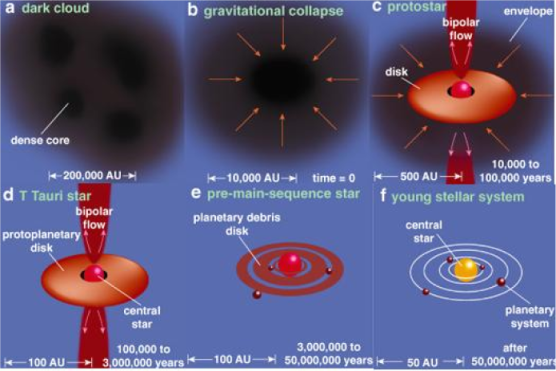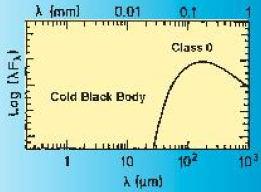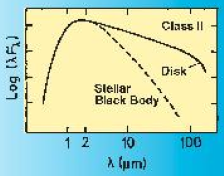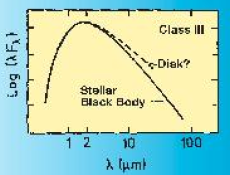Difference between revisions of "Studying Young Stars"
m |
|||
| (23 intermediate revisions by 2 users not shown) | |||
| Line 1: | Line 1: | ||
| − | + | =Why should anyone care about young stars?= | |
| − | |||
| − | |||
| − | |||
| − | |||
| − | |||
*Understanding star formation includes understanding how planets form, including planets like Earth. | *Understanding star formation includes understanding how planets form, including planets like Earth. | ||
*Star formation is the "happening field" right now! TONS of new discoveries happening all the time, many driven by Spitzer. | *Star formation is the "happening field" right now! TONS of new discoveries happening all the time, many driven by Spitzer. | ||
| Line 11: | Line 6: | ||
=Young stars in general: Introduction to (low-mass) star formation= | =Young stars in general: Introduction to (low-mass) star formation= | ||
| + | |||
| + | ''Also see this [http://coolcosmos.ipac.caltech.edu/resources/star_formation/ longer somewhat more technical intro to star formation], which I wrote for Cool Cosmos. https://web.ipac.caltech.edu/staff/rebull/starform/ This content too is the "story of star formation" if that cool cosmos link is dead. '' | ||
| + | |||
==Overview== | ==Overview== | ||
| Line 28: | Line 26: | ||
The star’s life so far has been governed by the continuous inward pressure of gravity. The gravitational pressure keeps compressing the gas into a smaller and smaller volume, making it hotter and hotter in the core. As soon as the temperature in the core of the protostar becomes great enough, nuclear fusion begins. When this nuclear fusion begins, finally the star has a way to "fight back" against gravity. So much energy is released in this reaction that it enables the star to "push back" with an outward radiation pressure that balances the inward push of gravity. The protostar is now a full-fledged star, fusing hydrogen into helium in its core. (f) The star will stay the same size until it runs out of nuclear fuel in the core (all of the hydrogen has been converted into helium). Then, the pressure from gravity takes over again, pushing in on the star. | The star’s life so far has been governed by the continuous inward pressure of gravity. The gravitational pressure keeps compressing the gas into a smaller and smaller volume, making it hotter and hotter in the core. As soon as the temperature in the core of the protostar becomes great enough, nuclear fusion begins. When this nuclear fusion begins, finally the star has a way to "fight back" against gravity. So much energy is released in this reaction that it enables the star to "push back" with an outward radiation pressure that balances the inward push of gravity. The protostar is now a full-fledged star, fusing hydrogen into helium in its core. (f) The star will stay the same size until it runs out of nuclear fuel in the core (all of the hydrogen has been converted into helium). Then, the pressure from gravity takes over again, pushing in on the star. | ||
| − | '''Movies!''' -- The sequence of star formation described above can also be visualized with some movies created by the Spitzer public affairs group. First [http://ipac. | + | '''Movies!''' -- The sequence of star formation described above can also be visualized with some movies (ARTIST CONCEPTIONS!) created by the Spitzer public affairs group. First [http://coolcosmos.ipac.caltech.edu/resources/star_formation/index.html#flash_video_player_01 form grains in the disk] (note that the grains are distinctly green because they are olivine, like green sand beaches in Hawaii, and the grains get covered in ice). Then [http://coolcosmos.ipac.caltech.edu/resources/star_formation/index.html#flash_video_player_02 form a planet that clears a gap in the disk]. Next, |
| − | [http://ipac. | + | [http://coolcosmos.ipac.caltech.edu/resources/star_formation/index.html#flash_video_player_03 this is what happens when you form many planets at once] - there are many gaps formed at once. (Where else in the Solar System have you seen this physics before? [http://saturn.jpl.nasa.gov/multimedia/images/raw/raw-images-details.cfm?feiImageID=112884 stumped?]) Of course, it can get crowded in these protoplanetary disks, so [http://coolcosmos.ipac.caltech.edu/resources/star_formation/index.html#flash_video_player_04 occasionally stuff hits each other], creating a second generation of dust. When this happens, [http://coolcosmos.ipac.caltech.edu/resources/star_formation/index.html#flash_video_player_05 the dust gets smeared out into a ring], and there can be many collisions that create transient dust, e.g., dust that comes and goes depending on when you look. Finally, [http://coolcosmos.ipac.caltech.edu/resources/star_formation/index.html#flash_video_player_07 you end up with a fully-fledged planetary system], but you have the remnants of the protoplanetary disk left in the outer reaches of the system. (What do we call this in our Solar System? hint: not the asteroid belt. out farther than that -- see in the movie, we go out well past a "jupiter".) |
==More in depth, and SEDs== | ==More in depth, and SEDs== | ||
| Line 43: | Line 41: | ||
{| cellpadding="2" | {| cellpadding="2" | ||
| [[Image:classI.png]] | | [[Image:classI.png]] | ||
| − | |This Class I SED is the next stage. Now there is a warmer blackbody corresponding to the central object, but most of the energy is still coming from the dusty cocoon around the star (which is reprocessed emission from the central object). The "bite" that is at about 10 microns tells us that there are silicates (beach sand) in the dust around the star. About this time is when the rate of accretion slows. The envelope is now about 0.1 Msun. The age of the object is about <math>10^5</math> years. | + | |This Class I SED is the next stage. Now there is a warmer blackbody corresponding to the central object, but most of the energy is still coming from the dusty cocoon around the star (which is reprocessed emission from the central object). The "bite" that is at about 10 microns tells us that there are silicates (beach sand) in the dust around the star. About this time is when the rate of accretion slows. The envelope is now about 0.1 Msun. The age of the object is about <math>10^5</math> years. (Note that there is now a Flat class between I and II -- see notes below.) |
|} | |} | ||
| Line 65: | Line 63: | ||
*A current major question in star formation is the how and why of this entire process. | *A current major question in star formation is the how and why of this entire process. | ||
*It’s not clear whether Class 0s and Is are found at the same age – until very recently, too few of them were known, and getting an age for them is tough. | *It’s not clear whether Class 0s and Is are found at the same age – until very recently, too few of them were known, and getting an age for them is tough. | ||
| − | *[http://www.spitzer.caltech.edu/ | + | *[http://www.spitzer.caltech.edu/news/172-ssc2004-17-Astronomers-Discover-Planet-Building-Is-Big-Mess- This press release] talks about A stars, which are a little massive for Class 0/I/II/III, but the confusion in disk clearing timescales is vividly displayed there. |
*We can be fooled! You can imagine that a Class III that is edge-on might look like a Class II. It could be that some things we think are the youngest protostars are actually just edge-on older things. There are other things that could matter too - binarity, initial and current rotation rate, initial and current accretion rate, and more. All of this is also one of the current burning questions. | *We can be fooled! You can imagine that a Class III that is edge-on might look like a Class II. It could be that some things we think are the youngest protostars are actually just edge-on older things. There are other things that could matter too - binarity, initial and current rotation rate, initial and current accretion rate, and more. All of this is also one of the current burning questions. | ||
*Most people still use the series Class 0-I-II-III to mean a series of youngest to oldest, but it’s important to remember all of these uncertainties. | *Most people still use the series Class 0-I-II-III to mean a series of youngest to oldest, but it’s important to remember all of these uncertainties. | ||
*Technically, there is also a "flat" class in between I and II because the SED is, well, flat. | *Technically, there is also a "flat" class in between I and II because the SED is, well, flat. | ||
| − | The details of the shape of the SED can tell us about the disk structure. Dips and wiggles in the SED may suggest, e.g., that there is no (or little) dust near the star, just further out. (see [http://www.spitzer.caltech.edu/ | + | The details of the shape of the SED can tell us about the disk structure. Dips and wiggles in the SED may suggest, e.g., that there is no (or little) dust near the star, just further out. (see [http://www.spitzer.caltech.edu/news/163-ssc2004-08-Raw-Ingredients-for-Life-Detected-in-Planetary-Construction-Zones this graphic from the SSC press release archive].) |
==Things to think about== | ==Things to think about== | ||
| Line 76: | Line 74: | ||
Nomenclature is a nightmare, as it is in so many parts of astronomy. See http://lanl.arxiv.org/abs/0901.1691v1 for examples of real-life flailing around with the wording. | Nomenclature is a nightmare, as it is in so many parts of astronomy. See http://lanl.arxiv.org/abs/0901.1691v1 for examples of real-life flailing around with the wording. | ||
| − | |||
| − | |||
| − | |||
| − | |||
| − | |||
| − | |||
| − | |||
Latest revision as of 22:21, 23 March 2023
Contents
Why should anyone care about young stars?
- Understanding star formation includes understanding how planets form, including planets like Earth.
- Star formation is the "happening field" right now! TONS of new discoveries happening all the time, many driven by Spitzer.
- A friend who is the author of a popular college textbook told me that the chapter that she revises most frequently (particularly recently) in response to new developments is the star formation chapter.
- By doing this project, you are participating in the revolution!
Young stars in general: Introduction to (low-mass) star formation
Also see this longer somewhat more technical intro to star formation, which I wrote for Cool Cosmos. https://web.ipac.caltech.edu/staff/rebull/starform/ This content too is the "story of star formation" if that cool cosmos link is dead.
Overview

|
Cartoon from Greene, American Scientist, Jul-Aug 2001 |
Stars begin their lives in a cloud of gas and dust (a nebula). Gravitational forces cause the nebula to start to condense (shrink). (a, b)
As the nebula shrinks, like a spinning skater pulling in her arms, it begins to spin more rapidly. The same physics ("conservation of angular momentum") means that the dust and gas in the nebula doesn't fall straight into the center; it falls onto a disk surrounding the central object, and from the disk, the matter falls onto the central object. The temperature at the center of the shrinking nebula rises due to increasing pressure and friction between the particles. The figure has this stage labeled as a "protostar", but for some astronomers, beginning at this stage, and until the star starts to turn H into He the object is still called a protostar. Since the protostar is still embedded in a thick cloud of gas and dust, it can't be detected in the optical. (c)
When the protostar enters the next stage, labeled in the figure as the T Tauri stage, it’s still gaining mass and contracting slowly because material is still falling onto it, but it begins to eject gas in two giant gas jets, called bipolar flows. These jets and stellar winds eventually sweep away the envelope of gas still surrounding the protostar. In the surrounding disk protoplanets are beginning to form. (d)
Leftover material in the disk surrounding the star clumps together and undergoes many collisions until most of the material has been swept up by objects orbiting the star, such as planets, asteroids and comets. (e)
The star’s life so far has been governed by the continuous inward pressure of gravity. The gravitational pressure keeps compressing the gas into a smaller and smaller volume, making it hotter and hotter in the core. As soon as the temperature in the core of the protostar becomes great enough, nuclear fusion begins. When this nuclear fusion begins, finally the star has a way to "fight back" against gravity. So much energy is released in this reaction that it enables the star to "push back" with an outward radiation pressure that balances the inward push of gravity. The protostar is now a full-fledged star, fusing hydrogen into helium in its core. (f) The star will stay the same size until it runs out of nuclear fuel in the core (all of the hydrogen has been converted into helium). Then, the pressure from gravity takes over again, pushing in on the star.
Movies! -- The sequence of star formation described above can also be visualized with some movies (ARTIST CONCEPTIONS!) created by the Spitzer public affairs group. First form grains in the disk (note that the grains are distinctly green because they are olivine, like green sand beaches in Hawaii, and the grains get covered in ice). Then form a planet that clears a gap in the disk. Next, this is what happens when you form many planets at once - there are many gaps formed at once. (Where else in the Solar System have you seen this physics before? stumped?) Of course, it can get crowded in these protoplanetary disks, so occasionally stuff hits each other, creating a second generation of dust. When this happens, the dust gets smeared out into a ring, and there can be many collisions that create transient dust, e.g., dust that comes and goes depending on when you look. Finally, you end up with a fully-fledged planetary system, but you have the remnants of the protoplanetary disk left in the outer reaches of the system. (What do we call this in our Solar System? hint: not the asteroid belt. out farther than that -- see in the movie, we go out well past a "jupiter".)
More in depth, and SEDs
The cartoon above is the version of this information that is appropriate for an "educated person from the general public." Now, let's look at this same story again, but using the kinds of plots and information used by professional astronomers.
A spectral energy distribution (SED) is a graph of the energy emitted by an object (any object) as a function of different wavelengths. ( Read more about SEDs here.) There are some example SEDs of young stellar objects below. Astronomers originally used the slope of the SEDs for protostars between about 2 and 20 microns quite literally to define different classes. (This is similar to the process that astronomers such as Annie Jump Cannon followed when they originally classified stars -- astronomers start by putting similar objects together, and through this process, eventually deeper physical understanding follows. I say eventually, because, sure, initially you might put the zebras and the tigers together because they're both stripey, but eventually you'll notice their feet are different, as is what they eat, and you'll put them in separate bins.) These stages that were defined based on the SED slope are dubbed Class I, II, and III. As we learned more, we created another class called "flat" between Class I and II. The very earliest stages, ones where there are no 2 micron observations at all, are the Class 0s. These classifications more or less match up to the overall sequence of events described by the cartoon above.
Several important notes about this classification scheme
- As the ages mentioned above suggest, this sequence of Class 0 to I to II to III is often interpreted as an age sequence, so a Class I object is younger than a Class II object, etc. Some of the most recent evidence suggests that maybe the connection to age is not as secure as we have been thinking! So let me just reiterate: the Class of each object is defined by the slope of the SED. The physical interpretation of the classification definition is degree of embeddedness, e.g., Class 0s are still buried deep within their natal cloud, and Class IIIs have freed themselves. The interpretation of the Class as an age may change.
- This process strictly only applies to low-mass stars. High-mass stars might very well do this, only faster. We just don’t know yet for sure.
- Class 0s are the the hardest to "catch in the act", from which we infer that they are the shortest lived. Not too long ago, the list of all of the Class 0s known could fit on one page. Spitzer is changing that. Class Is are also being found by Spitzer in abundance.
- Class 0s used to be defined as "undetectable in IR." Even before Spitzer, deeper integrations forced a change in that definition.
- Although the story seems nice and well-defined, even before Spitzer, Class IIs and IIIs have been found at the same ages, e.g., some stars lose their disks very quickly, and some hold on to them for a long time. Now with Spitzer, we're muddying the waters even more.
- (Also, although the story seems nice and well-defined, and it explains our Solar System nicely (with all the planets in the same plane, going the same direction, as they were in the disk that preceded them), we need to have theories to explain stuff like this too.)
- A current major question in star formation is the how and why of this entire process.
- It’s not clear whether Class 0s and Is are found at the same age – until very recently, too few of them were known, and getting an age for them is tough.
- This press release talks about A stars, which are a little massive for Class 0/I/II/III, but the confusion in disk clearing timescales is vividly displayed there.
- We can be fooled! You can imagine that a Class III that is edge-on might look like a Class II. It could be that some things we think are the youngest protostars are actually just edge-on older things. There are other things that could matter too - binarity, initial and current rotation rate, initial and current accretion rate, and more. All of this is also one of the current burning questions.
- Most people still use the series Class 0-I-II-III to mean a series of youngest to oldest, but it’s important to remember all of these uncertainties.
- Technically, there is also a "flat" class in between I and II because the SED is, well, flat.
The details of the shape of the SED can tell us about the disk structure. Dips and wiggles in the SED may suggest, e.g., that there is no (or little) dust near the star, just further out. (see this graphic from the SSC press release archive.)
Things to think about
Why is it that in most of the teacher programs looking for young stars, we've found Class II or III objects? Why have we not found many stars with jets or Class 0 or I objects? Hint: think about the lifetimes of these objects and statistical liklihoods.
Nomenclature is a nightmare, as it is in so many parts of astronomy. See http://lanl.arxiv.org/abs/0901.1691v1 for examples of real-life flailing around with the wording.



